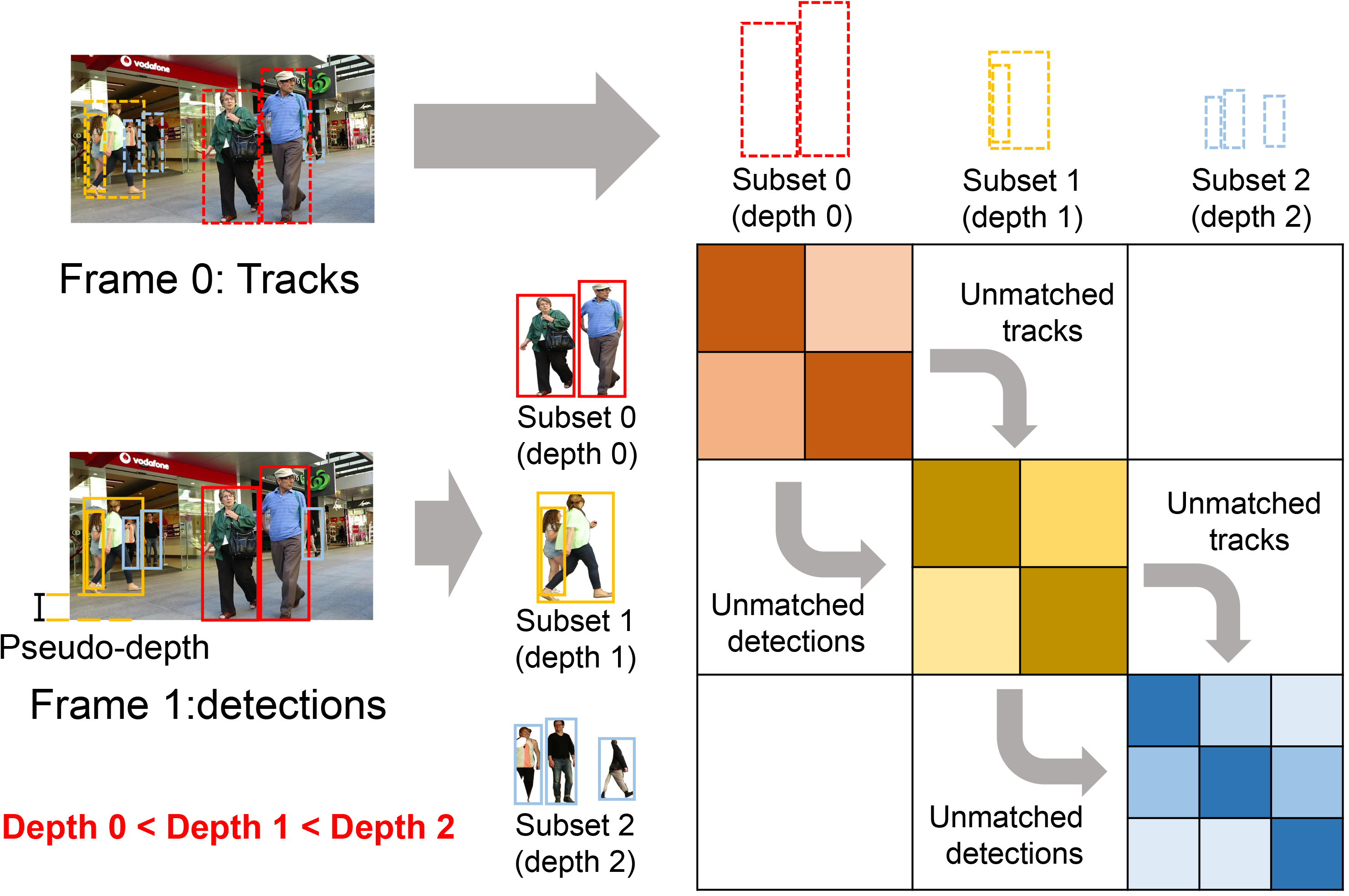SparseTrack: Multi-Object Tracking by Performing Scene Decomposition based on Pseudo-Depth
Zelin Liu, Xinggang Wang, Cheng Wang, Wenyu Liu, Xiang Bai
- Add yolov8 detector for tracking, please refer to branch v8.
Exploring robust and efficient association methods has always been an important issue in multiple-object tracking (MOT). Although existing tracking methods have achieved impressive performance, congestion and frequent occlusions still pose challenging problems in multi-object tracking. We reveal that performing sparse decomposition on dense scenes is a crucial step to enhance the performance of associating occluded targets. To this end, we propose a pseudo-depth estimation method for obtaining the relative depth of targets from 2D images. Secondly, we design a depth cascading matching (DCM) algorithm, which can use the obtained depth information to convert a dense target set into multiple sparse target subsets and perform data association on these sparse target subsets in order from near to far. By integrating the pseudo-depth method and the DCM strategy into the data association process, we propose a new tracker, called SparseTrack. SparseTrack provides a new perspective for solving the challenging crowded scene MOT problem. Only using IoU matching, SparseTrack achieves comparable performance with the state-of-the-art (SOTA) methods on the MOT17 and MOT20 benchmarks.
| Dataset | HOTA | MOTA | IDF1 | MT | ML | FP | FN | IDs |
|---|---|---|---|---|---|---|---|---|
| MOT17 | 65.1 | 81.0 | 80.1 | 54.6% | 14.3% | 23904 | 81927 | 1170 |
| MOT20 | 63.4 | 78.2 | 77.3 | 69.9% | 9.2% | 25108 | 86720 | 1116 |
| Method | HOTA | DetA | AssA | MOTA | IDF1 |
|---|---|---|---|---|---|
| SparseTrack | 55.5 (+7.8) | 78.9 (+7.9) | 39.1 (+7.0) | 91.3 (+1.7) | 58.3 (+4.4) |
| ByteTrack | 47.7 | 71.0 | 32.1 | 89.6 | 53.9 |
Notes:
- All the inference experiments are performed on 1 NVIDIA GeForce RTX 3090 GPUs.
- Each experiment uses the same detector and model weights as ByteTrack .
- SparseTrack relies on IoU distance association only and do not use any appearance embedding, learnable motion, and attention components.
This project is an implementation version of Detectron2 and requires the compilation of OpenCV, Boost.
step 1: Downloading pbcvt, copy the python_module.cpp to the path <pbcvt/src/>.
step 2: Adding the relevant OpenCV modules in the pbcvt/CMakeLists.txt file. Here's what you should do: locate the line "find_package(OpenCV COMPONENTS REQUIRED)" in the CMakeLists.txt file and replace it with "find_package(OpenCV COMPONENTS core highgui video videoio videostab REQUIRED)".
step 3: Modifying the compilation path in the Makefile file before compiling pbcvt. The main modifications include updating the following entries:CMAKE_SOURCE_DIR, CMAKE_BINARY_DIR, cmake_progress_start.
step 4: Compiling pbcvt. For example, you can run the following script:
cmake -DPYTHON_DESIRED_VERSION=3.X -DPYTHON3_INCLUDE_DIR=/home/lzl/miniconda3/envs/d2/include/python3.9 -DPYTHON3_NUMPY_INCLUDE_DIRS=/home/lzl/miniconda3/envs/d2/lib/python3.9/site-packages/numpy -DPYTHON3_LIBRARY=/home/lzl/miniconda3/envs/d2/lib/libpython3.9.so # and then, running: makestep 5: Please copy the "pbcvt.xxxxxx.so" file compiled via pbcvt to the <ROOT/SparseTrack/tracker/> directory.
git clone https://github.com/hustvl/SparseTrack.git
cd SparseTrack
pip install -r requirements.txt
pip install Cython
pip install cython_bboxDownload MOT17, MOT20, CrowdHuman, Cityperson, ETHZ and put them under ROOT/ in the following structure:
ROOT
|
|——————SparseTrack(repo)
| └—————mix
| └——————mix_17/annotations
| └——————mix_20/annotations
| └——————ablation_17/annotations
| └——————ablation_20/annotations
|——————MOT17
| └——————train
| └——————test
└——————crowdhuman
| └——————Crowdhuman_train
| └——————Crowdhuman_val
| └——————annotation_train.odgt
| └——————annotation_val.odgt
└——————MOT20
| └——————train
| └——————test
└——————Citypersons
| └——————images
| └——————labels_with_ids
└——————ETHZ
| └——————eth01
| └——————...
| └——————eth07
└——————dancetrack
└——————train
└——————train_seqmap.txt
└——————test
└——————test_seqmap.txt
└——————val
└——————val_seqmap.txt
Then, you need to turn the datasets to COCO format and mix different training data:
cd <ROOT>/SparseTrack
python3 tools/convert_mot17_to_coco.py
python3 tools/convert_mot20_to_coco.py
python3 tools/convert_crowdhuman_to_coco.py
python3 tools/convert_cityperson_to_coco.py
python3 tools/convert_ethz_to_coco.py
python3 tools/convert_dance_to_coco.py
Creating different training mix_data:
cd <ROOT>/SparseTrack
# training on CrowdHuman and MOT17 half train, evaluate on MOT17 half val.
python3 tools/mix_data_ablation.py
# training on CrowdHuman and MOT20 half train, evaluate on MOT20 half val.
python3 tools/mix_data_ablation_20.py
# training on MOT17, CrowdHuman, ETHZ, Citypersons, evaluate on MOT17 train.
python3 tools/mix_data_test_mot17.py
# training on MOT20 and CrowdHuman, evaluate on MOT20 train.
python3 tools/mix_data_test_mot20.py
See ByteTrack.model_zoo. We used the publicly available ByteTrack model zoo trained on MOT17, MOT20 and ablation study for YOLOX object detection.
Additionally, we conducted joint training on MOT20 train half and Crowdhuman, and evaluated on MOT20 val half. The model as follows: yolox_x_mot20_ablation
The model trained on DanceTrack can be available at google:yolox_x_dancetrack or baidu: yolox_x_dancetrack, the extracted key as: sptk
All training is conducted on a unified script. You need to change the VAL_JSON and VAL_PATH in register_data.py, and then run as follows:
# training on MOT17, CrowdHuman, ETHZ, Citypersons, evaluate on MOT17 train set.
CUDA_VISIBLE_DEVICES=0,1,2,3 python train.py --num-gpus 4 --config-file mot17_train_config.py
# training on MOT20, CrowdHuman, evaluate on MOT20 train set.
CUDA_VISIBLE_DEVICES=0,1,2,3 python train.py --num-gpus 4 --config-file mot20_train_config.py
Notes: For MOT20, you need to clip the bounding boxes inside the image.
Add clip operation in line 138-139 in data_augment.py, line 118-121 in mosaicdetection.py, line 213-221 in mosaicdetection.py, line 115-118 in boxes.py.
All tracking experimental scripts are run in the following manner. You first place the model weights in the <ROOT/SparseTrack/pretrain/>, and change the VAL_JSON and VAL_PATH in register_data.py.
# tracking on mot17 train set or test set
CUDA_VISIBLE_DEVICES=0 python3 track.py --num-gpus 1 --config-file mot17_track_cfg.py
# tracking on mot20 train set or test set
CUDA_VISIBLE_DEVICES=0 python3 track.py --num-gpus 1 --config-file mot20_track_cfg.py
# tracking on mot17 val_half set
CUDA_VISIBLE_DEVICES=0 python3 track.py --num-gpus 1 --config-file mot17_ab_track_cfg.py
# tracking on mot20 val_half set
CUDA_VISIBLE_DEVICES=0 python3 track.py --num-gpus 1 --config-file mot20_ab_track_cfg.py
step 1: Please comment out line 368-373 in the sparse_tracker.py and modify the threshold for low-score matching stage from 0.3 to 0.35 (at line 402 in the sparse_tracker.py).
step 2: Running:
CUDA_VISIBLE_DEVICES=0 python3 track.py --num-gpus 1 --config-file dancetrack_sparse_cfg.py
If you find SparseTrack is useful in your research or applications, please consider giving us a star 🌟 and citing it by the following BibTeX entry.
@inproceedings{SparseTrack,
title={SparseTrack: Multi-Object Tracking by Performing Scene Decomposition based on Pseudo-Depth},
author={Liu, Zelin and Wang, Xinggang and Wang, Cheng and Liu, Wenyu and Bai, Xiang},
journal={arXiv preprint arXiv:2306.05238},
year={2023}
}A large part of the code is borrowed from YOLOX, FairMOT, ByteTrack, BoT-SORT, Detectron2. Many thanks for their wonderful works.
